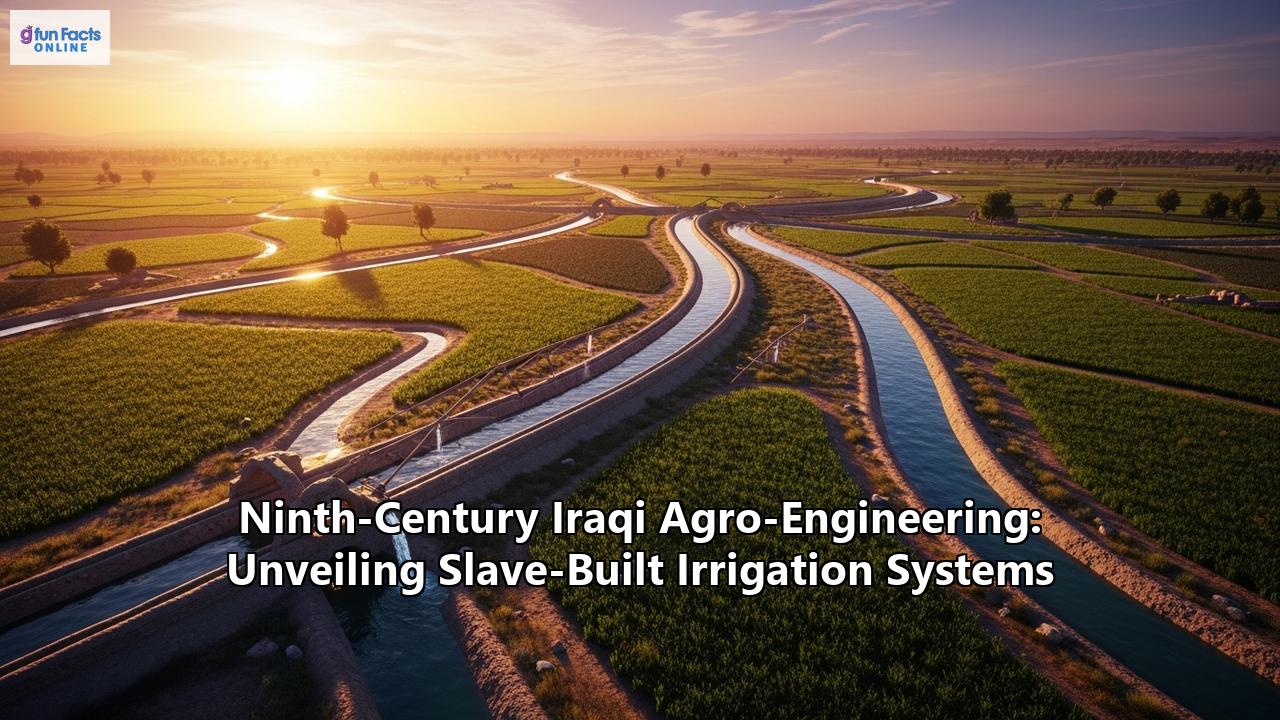In the heart of Mesopotamia, beneath the shifting sands of modern-day Iraq, lies evidence of a sophisticated and sprawling agricultural enterprise that powered the Abbasid Caliphate during the ninth century. This era, often lauded as a Golden Age of Islam for its scientific and cultural advancements, also relied on brutal realities to fuel its prosperity. Recent archaeological research has cast a stark light on the immense irrigation systems engineered during this period, and the enslaved workforce forced to construct and maintain them.
The fertile crescent, nurtured by the Tigris and Euphrates rivers, has been the cradle of civilization for millennia, with irrigation being a cornerstone of its agricultural productivity since ancient times. During the Abbasid Caliphate (750-1258 CE), which had its glittering capital in Baghdad, these ancient traditions were scaled to unprecedented levels. The 'Sawad', the rich alluvial plain of southern Iraq, became the breadbasket of the empire, its agricultural output crucial for feeding a burgeoning urban population and supporting a vast economy.
Engineering an Agricultural Marvel: The Canal SystemsThe Abbasids invested heavily in repairing, expanding, and creating new irrigation networks. Among the most notable of these was the Nahrawan Canal, a monumental system that drew water from the Tigris River to irrigate vast swathes of land east of the capital. This canal, with roots in the Sasanian period, reached its zenith under Abbasid rule, becoming a lifeline for Baghdad's water supply and the agricultural heartland that sustained it. The Nahrawan system was a complex network of main canals, distributaries, and smaller watercourses, stretching for hundreds of kilometers and demonstrating sophisticated engineering knowledge. Its construction and maintenance would have required immense labor and meticulous organization.
Historical texts describe how Abbasid caliphs and their administrations were actively involved in water management, recognizing its critical importance for both sustenance and state revenue. They established bureaus to oversee these large-scale hydraulic projects. Techniques such as qanats (underground channels), norias (water wheels), dams, and dikes were employed and refined to ensure efficient water distribution to the fields. This allowed for the cultivation of a variety of crops, including wheat, barley, rice, dates, cotton, and citrus fruits, some of which were new introductions requiring specific irrigation methods. The agricultural output was so significant that the Sawad region contributed the lion's share of tax revenue to the Abbasid treasury.
The Unseen Hands: Slave Labor and the Zanj RebellionWhile the agro-engineering feats of the Abbasids are impressive, a darker side to this agricultural boom has been brought into sharper focus by recent archaeological discoveries. For centuries, it was believed that enslaved people, primarily from East Africa and known as the Zanj, were instrumental in the back-breaking work of reclaiming land and maintaining these vast irrigation networks, particularly in the salt marshes of southern Iraq near Basra.
Recent studies, utilizing high-resolution satellite imagery, radiocarbon dating, and optically stimulated luminescence (OSL) analysis, have provided compelling physical evidence. Researchers have mapped an extensive network of over 7,000 agricultural ridges and irrigation channels spanning more than 500 square kilometers in the Shatt al-Arab floodplain. Crucially, the dating of these features places their construction and use between the late ninth and mid-thirteenth centuries CE. This timeline is significant because it coincides with and extends beyond the period of the Zanj Rebellion (869-883 CE).
The Zanj Rebellion was a massive and protracted uprising of enslaved Africans and other marginalized groups against the Abbasid Caliphate. Sparked by the horrific working conditions in the salt marshes – where laborers were forced to remove nitrous topsoil to make the land arable for little sustenance – the revolt grew to challenge the very authority of the Caliphate. Led by Ali ibn Muhammad, the Zanj established their own polity and even sacked major cities like Basra and Wasit before the rebellion was eventually crushed after 14 years of brutal conflict.
The archaeological findings suggest that the construction of these large-scale agricultural systems, likely using enslaved or coerced labor, did not cease with the Zanj Rebellion. In fact, the evidence indicates that such practices may have continued and even intensified in the rebellion's aftermath, representing a long-term investment in tidal irrigation that persisted for centuries. This engineered landscape stands as a testament to the immense human effort involved and the exploitative labor systems that underpinned the region's agricultural wealth. The discovery highlights the lasting environmental and economic impact of these enslaved populations, whose voices have been largely silenced in historical narratives.
A Legacy Etched in the LandThe intricate irrigation systems of ninth-century Iraq were a marvel of agro-engineering, transforming arid landscapes into productive agricultural heartlands. They supported a thriving civilization and contributed significantly to the economic power of the Abbasid Caliphate. However, this prosperity came at a tremendous human cost. The recent archaeological evidence powerfully underscores the role of enslaved laborers in creating and maintaining these vast networks.
The landscape of southern Iraq, with its thousands of ancient ridges and canals, is more than just a relic of past agricultural endeavors. It is a poignant reminder of the complex interplay between technological advancement, economic ambition, and the brutal realities of forced labor that shaped this critical period in history. Unveiling these slave-built irrigation systems allows for a more nuanced understanding of ninth-century Iraqi society, acknowledging not only its intellectual and engineering achievements but also the profound human suffering that was an integral part of its foundation. The ongoing research serves to give a voice to those marginalized individuals whose toil literally shaped the land, ensuring their contribution and suffering are not forgotten. The decline of these magnificent irrigation systems, mirroring the decline of the Abbasid Caliphate itself from the mid-10th century onwards, eventually led to the abandonment of large agricultural areas and a shift in the region's prosperity.
Reference:
- https://www.tutorchase.com/answers/ib/history/how-did-the--abbasids-influence-agriculture-and-irrigation-techniques
- https://islamichistory.org/islamic-golden-age/
- https://arkeonews.net/9th-century-slave-built-large-scale-agricultural-system-discovered-in-southern-iraq/
- https://tollbit.houstonchronicle.com/news/world/article/archaeologists-find-new-evidence-of-ancient-slave-20356739.php
- https://www.athensjournals.gr/history/2025-11-1-4-Sabir.pdf
- https://en.wikipedia.org/wiki/Mesopotamia
- https://en.wikipedia.org/wiki/Nahrawan_Canal
- https://www.britannica.com/place/Iraq/The-Abbasid-Caliphate
- https://en.wikipedia.org/wiki/Sawad
- http://www.diva-portal.org/smash/record.jsf?pid=diva2:1412801
- https://muslimheritage.com/waqf-endowment/
- https://ciaotest.cc.columbia.edu/isa/kaj01/
- http://www.diva-portal.org/smash/record.jsf?pid=diva2:1412806
- https://www.diva-portal.org/smash/get/diva2:1412806/FULLTEXT01.pdf
- https://brill.com/view/journals/jas/aop/article-10.1163-22142371-00802028/article-10.1163-22142371-00802028.xml
- https://muslimheritage.com/water-management/
- https://www.arhivzatehnickenauke.com/article/386/pdf
- https://oxfordre.com/africanhistory/display/10.1093/acrefore/9780190277734.001.0001/acrefore-9780190277734-e-933?p=emailASjPgTtl4OlLk&d=/10.1093/acrefore/9780190277734.001.0001/acrefore-9780190277734-e-933
- https://www.nmc.utoronto.ca/research-publications/faculty-publications/zanj-revolt-abbasid-caliphate
- https://ir.library.louisville.edu/cgi/viewcontent.cgi?article=3436&context=etd
- https://www.africarebirth.com/zanj-rebellion-the-african-slave-revolt-that-shook-the-islamic-world/
- https://www.ru.nl/en/research/research-news/dating-iraqs-ancient-irrigation-system
- https://www.anthropology.net/p/buried-grids-and-rebellious-ghosts

